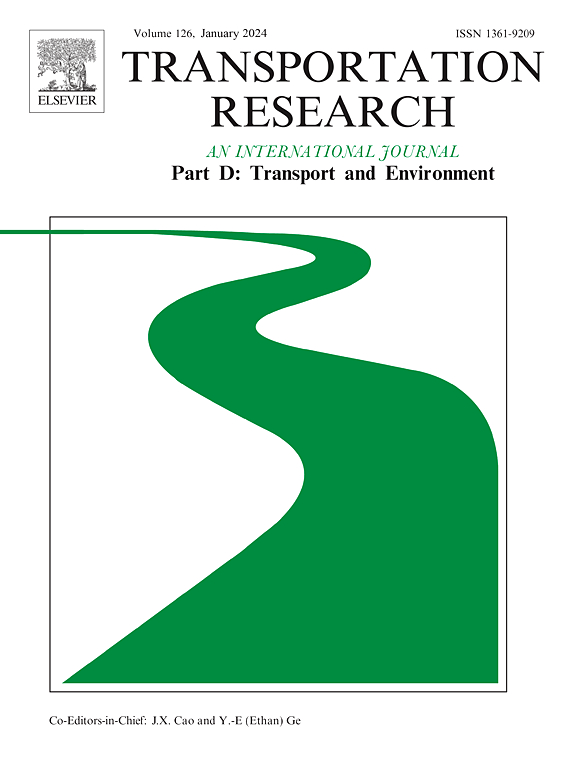城市道路网络中三轮机动三轮车实际排放模式的探索性评估
IF 7.7
1区 工程技术
Q1 ENVIRONMENTAL STUDIES
Transportation Research Part D-transport and Environment
Pub Date : 2025-09-20
DOI:10.1016/j.trd.2025.105006
引用次数: 0
摘要
本研究考察了以液化石油气(LPG)和汽油为燃料的三轮车在复杂城市环境中的真实排放特征和驾驶行为。汽油燃料的机动三轮车的排放量比LPG车型增加了1.93倍,HC+NO增加了1.55倍,而LPG车辆在高峰时段的二氧化碳排放量(g/km)增加了1.37倍。实际世界的排放量遵循多项式趋势,应用回归拟合有效地捕获了初始的随速度上升,并在LPG中速(10-20 km/h)之后保持稳定。在所有研究区域,加速导致排放量增加25 - 37%,而巡航导致排放量增加15 - 19%。该模型利用自然驾驶条件下的车速比均值数据求解车辆比功率(VSP)。现实世界的排放系数大大超过了巴拉特阶段(BS)的限制,这强调了加强交通管理战略以减少城市环境中车辆排放的必要性。本文章由计算机程序翻译,如有差异,请以英文原文为准。
Exploratory real-world emission modal assessment of three-wheeled autorickshaws in urban road networks
This study examines the real-world emission characteristics and driving behavior of Liquefied Petroleum Gas (LPG) and gasoline fueled three-wheeler vehicles in complex urban settings. The measured emissions from gasoline-fueled autorickshaws showed 1.93 fold increase for CO and 1.55 times higher for HC+NO than LPG models, while LPG vehicles recorded 1.37 times increased CO2 emissions (g/km) during peak-hour traffic. Real world emissions followed a polynomial trend, with applied regression fit effectively capturing the initial rise with speed and stabilizing beyond moderate speeds (10–20 km/h) for LPG. Acceleration led to 25–37 % rise in emissions, while cruising resulted in 15–19 % increase compared to idling across all study areas. The model utilized the speed specific bin-averaged data for vehicle specific power (VSP) under naturalistic driving conditions. Real world emission factor substantially exceeded Bharat Stage (BS) limits, emphasizing the need for enhanced transit management strategies to mitigate vehicular emissions in urban environments.
求助全文
通过发布文献求助,成功后即可免费获取论文全文。
去求助
来源期刊
CiteScore
14.40
自引率
9.20%
发文量
314
审稿时长
39 days
期刊介绍:
Transportation Research Part D: Transport and Environment focuses on original research exploring the environmental impacts of transportation, policy responses to these impacts, and their implications for transportation system design, planning, and management. The journal comprehensively covers the interaction between transportation and the environment, ranging from local effects on specific geographical areas to global implications such as natural resource depletion and atmospheric pollution.
We welcome research papers across all transportation modes, including maritime, air, and land transportation, assessing their environmental impacts broadly. Papers addressing both mobile aspects and transportation infrastructure are considered. The journal prioritizes empirical findings and policy responses of regulatory, planning, technical, or fiscal nature. Articles are policy-driven, accessible, and applicable to readers from diverse disciplines, emphasizing relevance and practicality. We encourage interdisciplinary submissions and welcome contributions from economically developing and advanced countries alike, reflecting our international orientation.

 求助内容:
求助内容: 应助结果提醒方式:
应助结果提醒方式:


